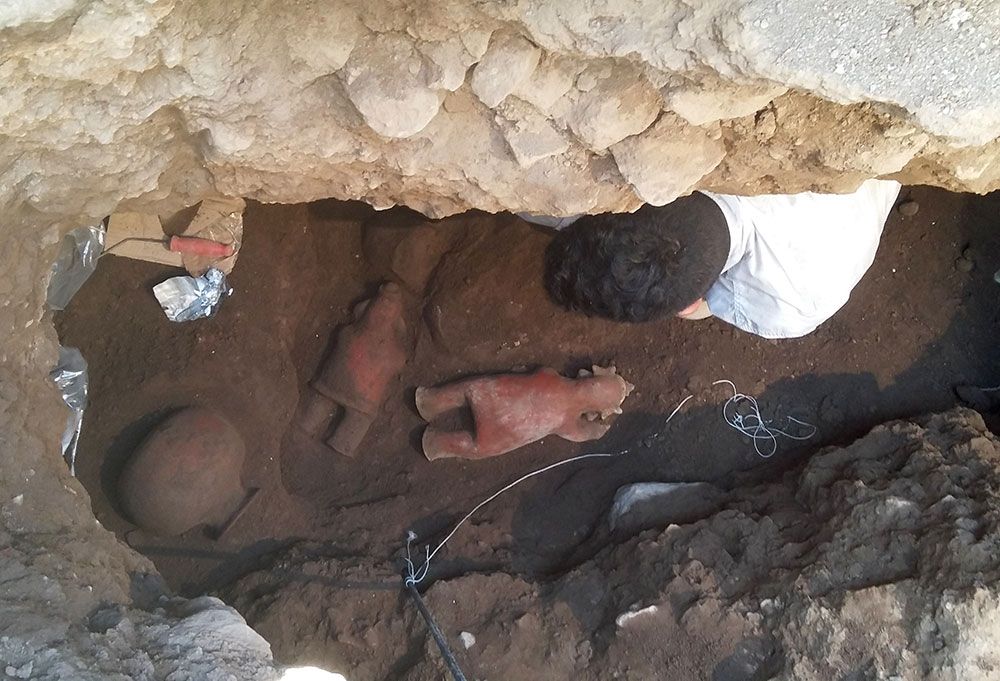
Editor's Note: This article was updated at 3 p.m. E.T.
A 1,700-year-old untouched tomb bearing the bones of a dozen male adults, as well as pre-Columbian figurines and statues, has been unearthed in Mexico.
Archaeologists discovered the ancient tomb, which dates to the Comala Period (between 0 and A.D. 500), during work to remodel a Seventh-day Adventist church in Colima, Mexico. The archaeologists uncovered a hole that was sealed up with stones, artifacts for grinding, and human bones.
Inside, 12 skulls and other bones were piled atop one another in a haphazard manner. Some of the skulls showed signs of damage, as well as tooth fractures and wear, said Rosa María Flores Ramírez, a physical anthropologist at the National Institute of Anthropology and History (INAH) in Mexico.
When the archaeologists explored further, they discovered three burial levels. In the second burial level, the team found two figurines — a male and female — placed facedown next to two skulls. [Prince's Tomb: Images from a Mayan Excavation]
Ancient figurines
The male figurine, which measures 15 inches (39 centimeters) tall and 6 inches (15 cm) wide, was wearing an elaborate headdress with a horn jutting out from it. In his hand, he holds an ax.
The female figurine, which is 12.5 inches by 5.5 inches (32 by 14 cm), shows a woman with a sharp nose and a triangular head. She wears a banded headdress and has her hands crossed, with the right hand holding a pot. The burial also contained two other pots.
Sign up for the Live Science daily newsletter now
Get the world’s most fascinating discoveries delivered straight to your inbox.
Each of the figures was sculpted from fine paste that was polished when complete. The ancient artists used cuts to etch in the facial features.
"The presence of these pieces in the offering hint at the worldview of the groups that inhabited the Colima valley in that period. The sculptures, according to their attributes, served as propitiatory elements that ensured the protection of the deceased, as is the case with the male sculpture, which represents a shaman. The other objects fulfilled the function of bringing the requirements to the underworld," Rafael Platas Ruíz, an archaeologist at the INAH, said in a translated statement.
The finding is rare because tombs of this type are almost invariably looted before archaeologists can get to them.
The fact that the tomb was untouched "allowed us to have a first approach with the bone remains, to observe the lesions, deformations and to have more information to know what was their way of life," the researchers said in the statement.
It's possible that this isn't the only burial in the area, because the entire Colima valley was occupied continuously from 1500 B.C. to A.D. 1500, and cultural relics from different periods in the city's history may be lying beneath it, the researchers said.
Editor's Note: This article was corrected to note that the figurine was wearing an elaborate headdress, not a feathered headdress.
Originally published on Live Science.

Tia is the managing editor and was previously a senior writer for Live Science. Her work has appeared in Scientific American, Wired.com and other outlets. She holds a master's degree in bioengineering from the University of Washington, a graduate certificate in science writing from UC Santa Cruz and a bachelor's degree in mechanical engineering from the University of Texas at Austin. Tia was part of a team at the Milwaukee Journal Sentinel that published the Empty Cradles series on preterm births, which won multiple awards, including the 2012 Casey Medal for Meritorious Journalism.











